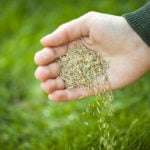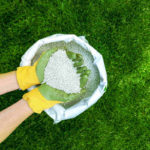
Improper lawn watering habits can lead to wasted water, added cost, and unhealthy grass. Lawns should only watered when a reasonable portion of the lawn shows signs of moisture stress. Indications that it’s time to water the lawn are a dark bluish-gray color, footprints that remain for some time after walking, and wilted, folded, or curled grass blades.
Irrigation is more effective than hand watering, however if irrigation isn’t an option then an alternative to irrigating your lawn is allowing the grass to go semi-dormant. Tall fescue, bermudagrass, and zoysiagrass are amazingly resilient and can tolerate dry conditions for up to two months if left alone.
General lawn watering tips:
1. Water in the early morning
Photo: Flickr / Conal Gallagher
Watering the lawn early in the morning is the best time to water because it reduces the risk of disease, water loss through evaporation, and negligent water distribution. We recommend any time between 4 am – 8 am to promote optimal grass health. (Also, the demand for water by industry and municipalities is usually low at this time.)
Watering at night invites mildew and fungal disease but if you can’t water in the morning aim for around 4 pm – 7 pm. Whereas watering in the heat of the day, much of your water can be lost to wind and evaporation. Plus, the water droplets act as tiny magnifying glasses and can scorch the grass during peak heat hours of the day.
2. Water more, less often
In order to encourage the root system to stretch deep into the ground, water the lawn to a depth of 6 – 8 inches. Most lawns only require an inch of water per week (including rainfall). Any more is actually bad for the lawn because it negatively affects drought tolerance. Ideally the lawn wouldn’t get the entire inch in one watering. Spacing out watering every 3 – 4 days and applying a ½ inch each time is an effective way to distribute the water.
3. Use cans or a rain gauge
How do you know how much you’ve watered unless you measure it? Use an empty tuna can or a rain gauge to determine how much water is being delivered over a certain time interval. It usually takes 640 gallons of water to distribute 1 inch of water per 1,000 square feet. (No wonder irrigation takes up the vast majority of water usage in the US!)
Final words
Photo: Flickr / Shane Stacks
If you don’t plan on irrigating throughout the summer, by circumstance or choice, there are precautions to take in order to prepare your lawn. It’s best to slowly ease an actively growing lawn into dormancy rather than halting all watering at once. The best way to do this is by allowing the drought stress symptoms to appear between watering, mowing high, and not over-fertilizing with nitrogen.
Have questions about lawn care? Visit our Durham lawn care page or share your thoughts in the comments section below.







